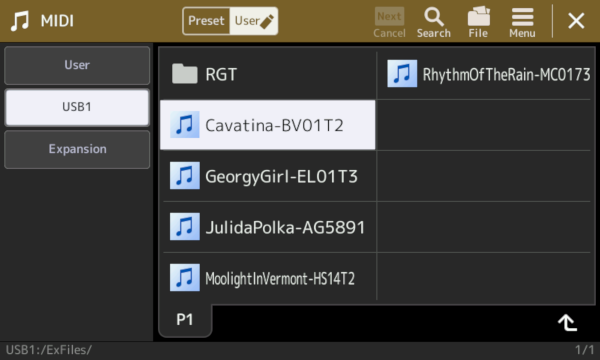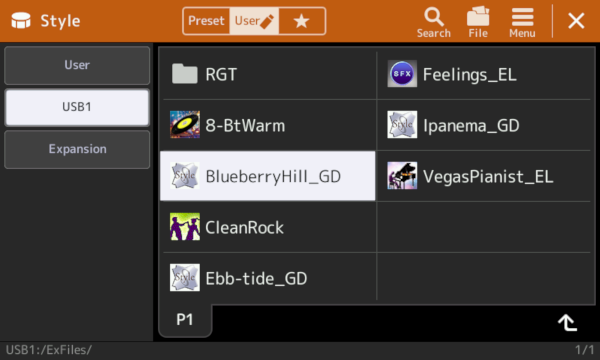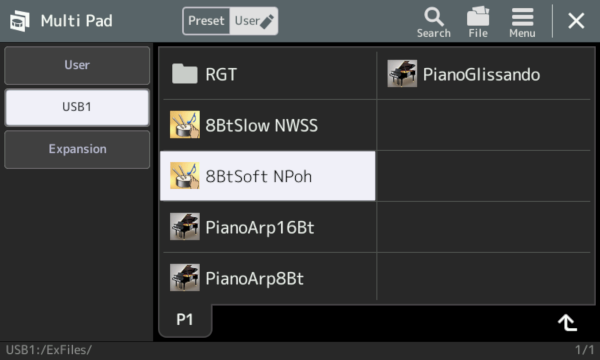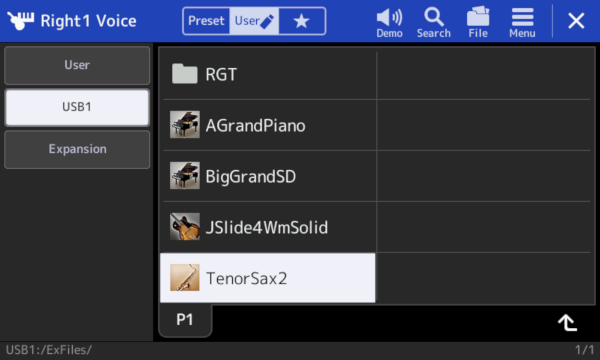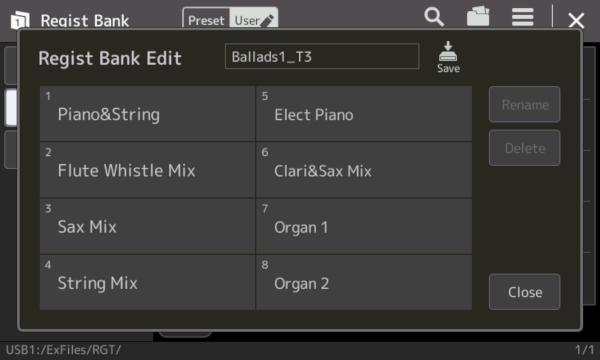To help explain the Yamaha file system, I will use a group of files that you can download from and use in your own keyboard. The files are in a zip file -- ExFiles.zip. Download this file and follow along with the discussion using your own keyboard. If you need help, you can check out the upcoming lessons in this section on File Downloads and File Compression.
I use screen shots from PSR-SX900 (for touch-screen models) and Tyros3 (for Tyros and PSR-S models) to accompany the discussion, so, even if you are not trying this on your keyboard, you get an idea of what is going on. Your screen may look a bit different with another keyboard, but all the key components will be the same.
Files in Your Personal Computer
If you download the example file ( called ExFiles.zip ) and unzip it, you find that it contains a folder called "ExFiles." Within that folder are 24 files as well as a subfolder called "RGT". I copied the ExFiles folder to a flash drive and examined the contents in a Windows File directory. The file listing is shown in Figure 1 below.
The
listing shows the full filename of each file. The filename has
two parts. The first part, the file name, can be just about whatever you want to use as the
name of the file. The second part, indicated by the ending period and three characters,
i.e. ".pad", ".mid", ".sty", indicates the "Type" of file. Windows can be set to show or to hide the "type" part of the filename.
File Types
A computer "file" generally holds data and/or instructions that tell a computer what to do. I'm using the term "computer" generically. Actually, the instructions are for a particular "program" within the computer.
For example, if you use Microsoft Word to create a word document, that document "file" would have a name that ends with ".doc". That ending identifies the files as a Microsoft Word document. The PC file system will associate an ending of ".doc" with the Microsoft Word program and if you try to "open" that doc file, your PC will launch Microsoft Word, which will open that file so that you can read and/or edit it. You could launch, if you want, your PC Notebook program, a text editor, and open the ".doc" file, but you might be surprised at what you see. The contents will not look like they do when you view it in Word. That's because the file itself includes not only the text included in your Word document, but all the instructions that you gave to format that text -- what margins to use, what font type, what font size, etc. Microsoft Word understands these instructions and uses them to format your text and show you the document. Notepad can not do that.
Associated Programs
In the listing above, song files, are identified by the ".mid" file type. Windows identifies this as a MIDI Sequence file. If you tried to open one of those ".mid" files on your PC, it would launch the whatever program on your PC is associated with midi files.
Style files in the listing above end with ".sty" or ".STY". The PC doesn't know what program to associate with these files, so they are listed with a Type of "STY File". If you tried to "open" one of these files in Notepad, you would see a screen filled with strange characters because the file contents include all the instructions needed by your Yamaha keyboard to create a style file. If, on the other hand, you tried to open this style file on your PC using Michael Bedesem's MidiPlayer program, that program would recognize the ".sty" file type and would load the style. You could then play parts of the style through the MidiPlayer program on your computer.
The bottom line here is that the "files" used by your Yamaha keyboard can be saved and listed, even renamed, in your personal computer, but unless you are using a PC program specifically for one of these file types, you will not be able to use these files on your PC; they are meant to be used in your Yamaha keyboard. In, addition, understand that the file "type", those last three letters, are important in helping your PC, and your keyboard, understand what the file is and where it would be used.
While we are looking at things from the PC perspective, let's open that
"RGT" folder and see what is in it (see Figure 2). This folder holds 11 files, all of which are registration files, which end
in ".REG" (used on the PSR-2000) or ".RGT" (used on more
recent keyboards). Registration files are keyboard specific. Your keyboard
may "recognize" all these file names when you are looking at registrations,
but, unless the file was made on a keyboard like yours, you will not be
able to load it and use it. The ".REG" file can not be read by newer keyboards.
On your PC, if you were using a program like Microsoft Word and you opened a folder to load a document, Word would show you all the Word files in that folder. It would not show you files Word could not use unless you specifically asked to view ALL files. You'll soon see that your Yamaha operates much the same way. When you are looking to play a song, it will show you only the song files. Let's take a look now at how your Yamaha would handle these files.
Files In Your Yamaha Keyboard
With your sample files on a flash drive, take that flash drive to your keyboard and see what's there. While most Yamaha arranger keyboards can read these files, how you find and load the various files is different on the new touch-screen models than on earlier Tyros and PSR models. For this reason, we split the remaining discussion into two parts. The first covers the PSR-SX900 (and Genos) models and the second focuses on the earlier Tyros and PSR-S models. If you have an earlier model, jump down to the discussion on the TYROS/PSR Models.
Files on the PSRSX-900
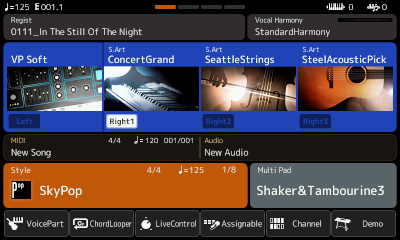 Here is the Home page of the PSR-SX900 with the default style file, SkyPop, loaded. The voices and the multi pad are those associated with SkyPop.
Here is the Home page of the PSR-SX900 with the default style file, SkyPop, loaded. The voices and the multi pad are those associated with SkyPop.
(Note that on this, and other screen shots from the SX900, you can click on the image to open a larger view of that screen.)
The Start Here lessons showed how you can access many different kinds of files from the Home screen. To access voices, touch any of the displayed voice boxes. To access styles, touch the Style box. To access multi pads, touch the Multi Pad box. To access MIDI files, touch the MIDI box. Finally, to access a registration file, touch the Regist box above the Left Voice box. Of course, you can also use keys on your keyboard to access files as well. For example, push any style category button to open the Style selection screen.
In this exercise, we are going to look at what each screen shows us when we access that ExFiles folder on a USB drive. All of the files in that folder represent files used by Yamaha arranger keyboards. There are style files, midi files, voice files, multi pad files and more. If you are follwing along, copy that folder to your own USB drive and plug it into your keyboard.
SONG Files
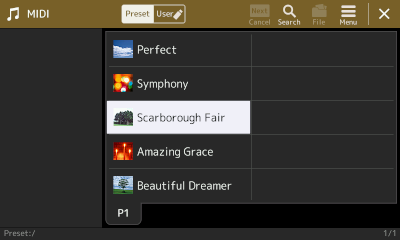 OK,
let's look for song files in the ExFiles folder. MIDI song files are the ones with the ".mid"
file extension. From the Home screen press the MIDI box to open up the
SONG display screen. The MIDI screen opens up showing you the Preset area where the songs included with your PSR-SX900 keyboard are found. For this and the subsequent screens, touch the User box next to Preset to go to the User area and, from there, touch the USB1 box to see files on the USB drive. You will see a folder called "ExFiles". Touch the folder name to open that folder and see the files in the folder. Since you are viewing that folder through the MIDI screen, you will see all the MIDI files and all the subfolders as shown in the screen shot below.
OK,
let's look for song files in the ExFiles folder. MIDI song files are the ones with the ".mid"
file extension. From the Home screen press the MIDI box to open up the
SONG display screen. The MIDI screen opens up showing you the Preset area where the songs included with your PSR-SX900 keyboard are found. For this and the subsequent screens, touch the User box next to Preset to go to the User area and, from there, touch the USB1 box to see files on the USB drive. You will see a folder called "ExFiles". Touch the folder name to open that folder and see the files in the folder. Since you are viewing that folder through the MIDI screen, you will see all the MIDI files and all the subfolders as shown in the screen shot below.
There were six ".mid" files in the folder and you see all six files as well as the RGT FOLDER. Note that the lower left-hand corner of this screen shot shows the path to this page as "USB1:/ExFiles/". What you DO NOT see are any of the other files in that folder. In this screen shot, the "Cavatina-BV01T2" file is selected (by simply touching the file name) and, if you return to the Home page, you see that file listed in the MIDI box. Try out any of the midi files. They should all play on your keyboard.
If you were to open the RGT folder at this point by touching the folder name, you would see a blank screen, that is, no files are listed in that folder. We know that there are files there, but none of them are song files so the folder appears to be empty. The fact that the folder shows no entries through the MIDI display screen is NOT A REASON to delete that folder. It may, indeed, in this case, does, contain files other than midi song files.
![]() If you opened the RGT folder, you can return to
its parent folder by pressing the up button indicated by the upward facing arrow in the bottom-right corner.
If you opened the RGT folder, you can return to
its parent folder by pressing the up button indicated by the upward facing arrow in the bottom-right corner.
Style Files
Let's now look at the style files in the ExFiles folder. From the HOME screen, touch Style box and from the Style screen select User and then the USB1 area. Open up the ExFiles folder by touching it. That reveals the following screen:
The ExFiles folder included seven .sty or .STY files. They are all visible in this Style screen. The RGT folder is also visible. You are not seeing the file extension, only the file name. The file extension was used to determine which of the files in that folder would be shown in the STYLE display screen. You can load any of these styles by touching the style name. In this figure, "BlueberryHill_GD" was selected.
The first style file is shown as 8-BtWarm. On the PC, that file was listed as "8-BtWarm.s781.STY". The ".STY" indicated a style file and you can see the name in the window, but what is that ".s781" part of the filename? That is a code indicating what ICON to show next to the filename. The icon specification is optional. If you check the original listing, there is no icon code for BlueberryHill, Ebb-tide, or Ipanema. A default ICON is used for these files. When you are naming a file, you can not only provide the characters for the filename, you can also select the icon that will be used with that file. The icons are for your own use, they have no impact on how the style plays. The next lesson covers various file operations, like naming a file.
If you repeated the exercise of checking the RGT folder, you would again see nothing in the folder since there are no style files in that folder. Feel free to try out any of the style files. Although these styles were created years ago on earlier models, they should play fine on your keyboard.
Multi Pad Files
You should now be a pro at getting to files on that ExFiles folder on the USB drive. From the Home screen, touch the Multi Pad box, then the User box and the USB1 area. Open up the ExFiles folder. That gets you to the following Multi Pad screen:
The folder includes five ".pad" files and that is exactly what the Multi Pad screen shows you, as well as the RGT folder. I selected the "8BtSoft NPoh" pad file. That selection did not alter the currently loaded style, nor did it alter the Multi Pad that is stored in that style. In future lessons you will see how you can modify the style itself to change the Multi Pad style stored with that style and many other aspects of the style.
Voice Files
Touch the Right1 voice and let's replace that with a voice from the ExFiles folder. Touch User, USB1, and ExFiles folder to produce this page:
There are four voice files in that ExFiles folder: AGrandPiano.S003.liv, BigGrandSD.S004.vce, JSlide4WmSolid.S121.clv, and TenorSax2.S230.swv. Those voices are shown in this Right1 Voice screen where "TenorSax2" was selected.
These "voice" files are not like the sampled voices that are delivered with your keyboard. You can take any of those preset voices and modify the voice by changing some of the parameters that define that voice. When you get, for example, your preferred version of a Grand Piano voice, you can save that as a new voice. What is actually being saved are the parameter changes you made to the preset voice. Loading those changes and applying them to the original preset voice reproduces all the modifications you made to create your "new" voice. Needless to say, you may get mixed results when applying a voice file like this created on an earlier keyboard to your own keyboard.
Registration Files
You access the registration files screen by pressing the Regist box on the Home screen or by pressing the two REGIST BANK SELECT buttons on the keyboard below the Home screen. Navigate down to User > USB1 > ExFiles folder and open it. You need to also open up that RGT folder. This gives you the Regist Bank screen showing the registration files in the USB1:/ExFiles/RGT folder.
There are 11 registration files in that folder. 10 of them had a file type of ".RGT" and all 10 are displayed in the screen shot above. One registration file ending in ".REG" originated on the PSR-2000. The ".RGT" registrations are compatible with the SX900 and these all loaded. The ".REG" registration is too old and is not compatible so it is not shown.
The "Ballad1_T3" is a registration that provides 8 different voices for use with Ballads. The "COUNTRY1_3k" registration is one that provides 8 different styles suitable for country songs. Several of the registrations are for gigs and provide the setup for 8 specific songs.
Touch the Menu button on the Regist Bank screen and select Regist Bank Edit. This will show you a name for each of the 8 registration bank buttons in Ballads1_T3.
With all the selections made above, the Home screen now shows all of the files loaded from the ExFiles folder on the USB drive. The Regist box shows the "Ballads1_T3" registration. The Right1 voice shows the "TenorSax2" voice. The MIDI box shows the "Cavatina-BV01T2" song. The Style box shows that the "BlueberryHill_GD" style is loaded. The Multi Pad box shows the "8Bt Soft NPoh" multi pad file.

Music Finder
The newest of the Yamaha PSR-SX models had no trouble loading a variety of files from earlier keyboards. However, some files in that ExFiles folder have not been covered. There are three ".mfd" files, representing three Music Finder databases. The Tyros and PSR-S models can load these Music Finder databases, but the Music Finder is not part of the PSR-SX900 or the Genos keyboards. That feature has been replaced by the Playlist feature. We won't discuss that here, but rest assured, the PSR-SX900 can convert those Music Finder databases into Playlists. But that will be covered in a later lesson.
Hopefully, this exercise gives you a better feel for how the Yamaha interacts with files and folders. Most new users forget that specific screens only show specific types of files. For example, suppose you create a registration for a particular song and save that registration naming it after the song. If you look in the MIDI box, you won't find your song. If you look in the Style box, you will not find your song. If it was actually saved as a registration file, you can only find it again if you are looking in the Regist Bank screen.
Of course, you may not have any idea how to save any of these files. Fortunately, you are now ready to jump to the next lesson that explains how to manipulate all of these various file types.
Files on the Tyros and PSR-S Models
Below is the MAIN screen from a Tyros3 keyboard. Note that the screen title is shown at the very top of the screen.
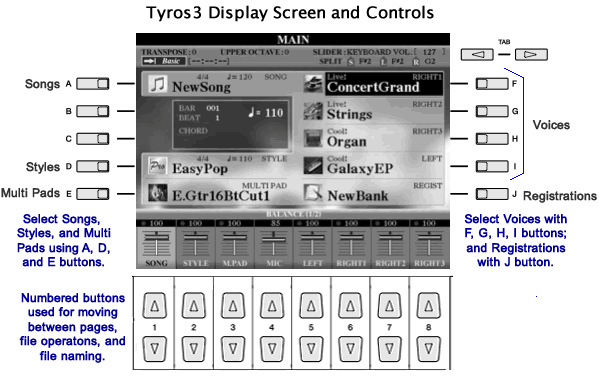
This is your entry point to selecting many of the different files. Use the [A] button to access song files; the [D] button, Style files; the [E] button, Multi Pads; and the [J] button, registration files. All the voice buttons, [F], [G], [H], and [I] will access voice files. The RIGHT3 voice is only available on the Tyros models and the the position of Styles and MultiPads may be different on your keyboard, but all these choices should be somewhere on your MAIN screen.
The numbered buttons below the MAIN screen will be used for selecting "pages" when looking at file directories, for selecting file options, and for entering characters when naming a file. The [TAB] buttons will be used to move between the various storage locations (PRESET, CARD/FLOOPY, USB, HD). You will soon become very adept at selecting files or choosing options by using the buttons surrounding your keyboard's MAIN screen.
Song Files
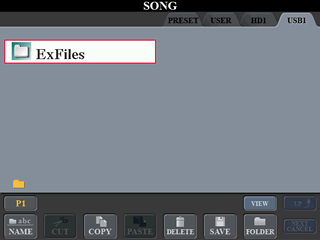 OK,
let's take a look at our example song files, the ones with the ".mid"
file extension. From the MAIN screen press the [A] button to open up the
SONG display screen. Again, take note that the word "SONG" appears on the first line of the screen telling you that this is the SONG Display screen. You will initially be looking at the PRESET area where
the SampleSongs folder from Yamaha is stored.
Use the [TAB] buttons to tab over to your USB1 drive. The screen shot here
is showing my USB drive. I had removed everything from my drive except the
sample files so my USB drive is showing only one folder, ExFiles.
I know this is a folder because there is a folder icon displayed by the folder name. That is how
you recognize folders rather than files. That folder is located next to the
[A] button, so press the [A] button to select and open the folder.
OK,
let's take a look at our example song files, the ones with the ".mid"
file extension. From the MAIN screen press the [A] button to open up the
SONG display screen. Again, take note that the word "SONG" appears on the first line of the screen telling you that this is the SONG Display screen. You will initially be looking at the PRESET area where
the SampleSongs folder from Yamaha is stored.
Use the [TAB] buttons to tab over to your USB1 drive. The screen shot here
is showing my USB drive. I had removed everything from my drive except the
sample files so my USB drive is showing only one folder, ExFiles.
I know this is a folder because there is a folder icon displayed by the folder name. That is how
you recognize folders rather than files. That folder is located next to the
[A] button, so press the [A] button to select and open the folder.
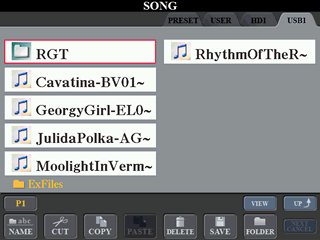 We
are now looking at the contents of the "ExFiles" folder. You can
tell that by looking at the bottom left of the USB1 display (right below MoonlightInVermont and above the P1 page indicator), which shows
the folder icon and the folder name "ExFiles".
We
are now looking at the contents of the "ExFiles" folder. You can
tell that by looking at the bottom left of the USB1 display (right below MoonlightInVermont and above the P1 page indicator), which shows
the folder icon and the folder name "ExFiles".
The song list shows us a folder, RGT, and five songs. It is not showing any of the other files that you know are in that folder on your USB drive. Because we are looking at "SONG" files, your Yamaha is only showing you the song files, those with a ".mid" or ".MID" file extension, in that folder. If you were to examine the RGT folder at this point by pressing the [A] button to open it, you would see a blank screen, that is, no files in that folder. We know that there are files there, but none of them are song files so the folder would appear to be empty. The fact that the folder shows no entries through the SONG display screen is NOT A REASON to delete that folder. It may, indeed, in this case, does, contain files other than song files.
If you open the RGT folder, you can return to its parent folder by pressing the UP button, which would be the upper [8] button below the screen. Back to our set of sample midi files you may note that the file titles are truncated. You only see as much of the title as will fit on half the screen. This may encourage you to use short titles or abbreviations in your filenames. While the PC can display a very long filename, your Yamaha is limited in how many characters you will be able to see in the filename.
You can select any song to load and play by using the corresponding lettered button. Let's try Cavatina by pressing the [B] button. This will highlight the song name. Press the [EXIT] button to return to the MAIN screen. If you double-click the song name, this will select the song and automatically return you to the MAIN screen.
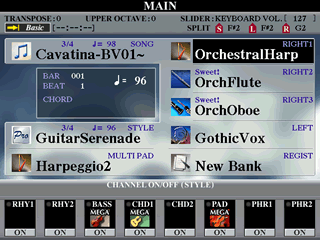 Back
at the MAIN screen the contents of the SONG cell has now changed from "NewSong"
to "Cavatina-BV01~". You can now use your panel SONG buttons
to Play/Pause this song. This particular song was using a preset style, GuitarSerenade,
so when we loaded the song, the keyboard also loaded that style and it's
associated voices.
Back
at the MAIN screen the contents of the SONG cell has now changed from "NewSong"
to "Cavatina-BV01~". You can now use your panel SONG buttons
to Play/Pause this song. This particular song was using a preset style, GuitarSerenade,
so when we loaded the song, the keyboard also loaded that style and it's
associated voices.
The "NewSong" that had been showing in that [A] cell was a default empty song file that Yamaha loaded when you turned on your keyboard. If you were to turn on the record feature and try some quick recording, you would be saving to that "NewSong" file. To save your recording you would have to save the file although you would want to name it something other than "NewSong" to distinguish your recording from Yamaha's default new song name. The "Naming Files" lesson in this section will explain how you can change the name of a file.
If you wanted to adjust the Cavatina midi file, you could do that. But if you wanted to save your changes, you would want to save your modified midi file under a different name. While you can not change any of the preset files in your keyboard, you can, indeed, change files in one of the other storage areas. So, if you modified the Cavatina song file and "saved" it using the same filename, you would, in fact, be replacing the version on the USB drive with a different version. If you don't want to replace an original file, simply save it under a modified filename and you will have both the original version and your modified version available. Feel free to audition the other midi files in the sample file set.
Style Files
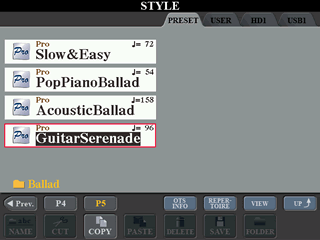 Let's
now take a look at the example style files. From the MAIN screen, press the
[D] button to select a new style. If you are following the example here, you were trying out Cavatina, which used
the GuitarSerenade style. If that is the currently loaded stoye, the STYLE Display Screen opens up showing the GuitarSerenade style, a PRESET style located in the "Ballad" folder. If the midi file was not using one of your preset styles, than
whatever style you had previously loaded would still be there and the STYLE
screen would open up to that style.
Let's
now take a look at the example style files. From the MAIN screen, press the
[D] button to select a new style. If you are following the example here, you were trying out Cavatina, which used
the GuitarSerenade style. If that is the currently loaded stoye, the STYLE Display Screen opens up showing the GuitarSerenade style, a PRESET style located in the "Ballad" folder. If the midi file was not using one of your preset styles, than
whatever style you had previously loaded would still be there and the STYLE
screen would open up to that style.
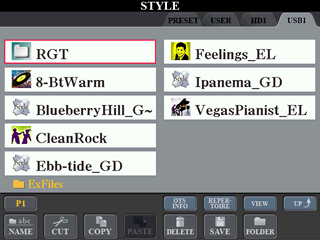 We
want to see what is in the ExFiles folder on the USB drive, so tab over to
the USB1 area and open the ExFiles folder. Now, you see that same RGT folder
and 7 style files. Note that you are not seeing the file extension, only
the file name. The file extension was used to determine which of the files
in that folder would be shown in the STYLE display screen.
We
want to see what is in the ExFiles folder on the USB drive, so tab over to
the USB1 area and open the ExFiles folder. Now, you see that same RGT folder
and 7 style files. Note that you are not seeing the file extension, only
the file name. The file extension was used to determine which of the files
in that folder would be shown in the STYLE display screen.
The first style file is shown as 8-BtWarm. On the PC, that file was listed as "8-BtWarm.s781.STY". The ".STY" indicated a style file and you can see the name in the window, but what is that ".S781" part of the filename? That is a code indicating what ICON to show next to the filename. The icon specification is optional. If you check the original listing, there is no icon code for BlueberryHill, Ebb-tide, or Ipanema. So, the Tyros3 simply inserts a default ICON for these files. When you are naming a file, you can not only provide the characters for the filename, but also select the icon that will be used with that file. The icons are for your own use, they have no impact on how the style plays.
If you repeated the exercise of checking the RGT folder, you would again see nothing in the folder since there are no style files in that folder. Feel free to try out any of the style files. I'm going to try out VegasPianist_EL.
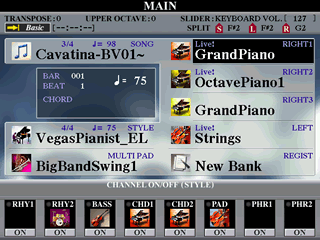 Selecting
that style and returning to the MAIN screen you see that the STYLE cell now
shows VegasPianist_EL and that the voices have been
changed to reflect the OTS settings in this style. This has not impacted
the SONG cell -- Cavatina-BV01~ is still sitting there. The Multi Pad, however,
has also been changed since that, too, is stored with the style. Of course,
you don't have to keep that Multi Pad file. You could load a different Multi
Pad file to use with this style. Let's see what Multi Pad files are included
in the ExFiles folder.
Selecting
that style and returning to the MAIN screen you see that the STYLE cell now
shows VegasPianist_EL and that the voices have been
changed to reflect the OTS settings in this style. This has not impacted
the SONG cell -- Cavatina-BV01~ is still sitting there. The Multi Pad, however,
has also been changed since that, too, is stored with the style. Of course,
you don't have to keep that Multi Pad file. You could load a different Multi
Pad file to use with this style. Let's see what Multi Pad files are included
in the ExFiles folder.
Multi Pad Files
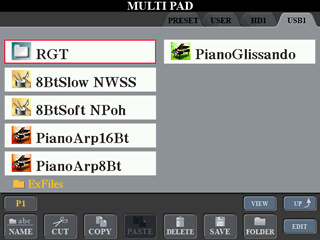 Press
the [E] button to open up the MULTI PAD display screen. Check that top line and make sure it says MULTI PAD to be sure you are looking at the Multipad files. Tab over to the
USB drive. Looking in the ExFiles folder, you see
the RGT subfolder
and, now, five multipad files. No songs or styles, although they are still
in that folder. Since we are looking for Multi Pad files, ".pad",
those are the only files shown. Again, we see the filename along with an
icon. Select any of the Multi Pads and try them out.
Press
the [E] button to open up the MULTI PAD display screen. Check that top line and make sure it says MULTI PAD to be sure you are looking at the Multipad files. Tab over to the
USB drive. Looking in the ExFiles folder, you see
the RGT subfolder
and, now, five multipad files. No songs or styles, although they are still
in that folder. Since we are looking for Multi Pad files, ".pad",
those are the only files shown. Again, we see the filename along with an
icon. Select any of the Multi Pads and try them out.
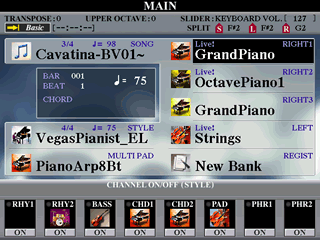 I
selected the PianoArp8Bt Multi Pad and you see
that in the MULTIPAD cell on the MAIN screen here. That selection did not
alter the currently loaded style, nor did it alter the Multi Pad that is stored
in that style. In future lessons you will see how you can modify the style
itself to change the Multi Pad style stored with that style and many other
aspects of the style.
I
selected the PianoArp8Bt Multi Pad and you see
that in the MULTIPAD cell on the MAIN screen here. That selection did not
alter the currently loaded style, nor did it alter the Multi Pad that is stored
in that style. In future lessons you will see how you can modify the style
itself to change the Multi Pad style stored with that style and many other
aspects of the style.
If you were to simply save the VegasPianist style now with a new name so you could have a "new" copy, you would not be saving it with a different Multi-Pad -- that is a more complex process. However, if you wanted to change the voices used in the OTS, that could be accomplished by simply creating a new OTS and saving the file as you normally do. Note that the currently selected Multi Pad file would also be saved in the OTS button. So, let's look at some of the voices provided with the example files.
Voice Files
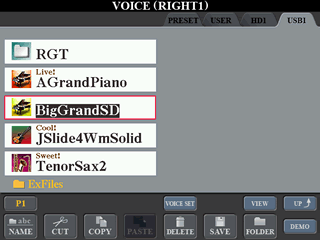 Press
the [F] file to open up the VOICE display screen for the RIGHT1 voice. Voice
files (.vce, .liv, .swv, .clv) are shown in the VOICE display screen. All
of the keyboards come with preset voices. Users can alter various voice parameters
and modify the sound of any instrumental voice and save that as a "new" voice
file. These files are very small since what gets saved is not the initial
voice file, but the parameter changes used in altering that voice file.
For this reason, a voice created on the PSR3000 may sound very different
if that voice is loaded into a Tyros3.
Press
the [F] file to open up the VOICE display screen for the RIGHT1 voice. Voice
files (.vce, .liv, .swv, .clv) are shown in the VOICE display screen. All
of the keyboards come with preset voices. Users can alter various voice parameters
and modify the sound of any instrumental voice and save that as a "new" voice
file. These files are very small since what gets saved is not the initial
voice file, but the parameter changes used in altering that voice file.
For this reason, a voice created on the PSR3000 may sound very different
if that voice is loaded into a Tyros3.
The preset voices of the Tyros3, particularly the Super Articulation2 voices, are very realistic and one of the main reasons for moving up to that keyboard. Unfortunately, you can not take a voice from the Tyros3 and play it on earlier keyboards. The Tyros models also allow for the addition of sampled voices. These voice files can be very large and usually require additional memory. These files are very different from the voice files you see in the example file set. Go ahead and try out some of these voices and see if they work on your keyboard.
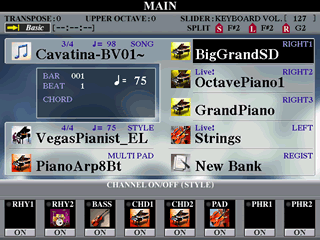 OK,
we're back at the MAIN display screen where I have replaced the RIGHT1 voice
with the BigGrandSD voice. I can play the style using this new
voice in RIGHT1. However, if I were to press the OTS1 button, the voice would
revert back to the original GrandPiano voice. But, if I were to press
[MEMORY] and then the OTS1 button, it would save the current right-hand voices
in the OTS1 memory button. I could use this method to change any of the voices
used in any of the OTS buttons. To save my "new" OTS settings,
I would simply save the currently loaded file, probably under a new name,
and the current OTS settings would be saved with that new file.
OK,
we're back at the MAIN display screen where I have replaced the RIGHT1 voice
with the BigGrandSD voice. I can play the style using this new
voice in RIGHT1. However, if I were to press the OTS1 button, the voice would
revert back to the original GrandPiano voice. But, if I were to press
[MEMORY] and then the OTS1 button, it would save the current right-hand voices
in the OTS1 memory button. I could use this method to change any of the voices
used in any of the OTS buttons. To save my "new" OTS settings,
I would simply save the currently loaded file, probably under a new name,
and the current OTS settings would be saved with that new file.
Registration Files
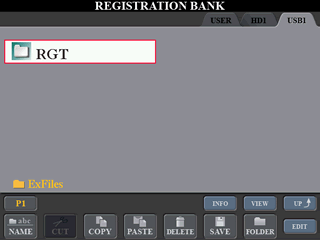 You'll
learn all about registration files in the Registrations lesson
section. But let's take a few moments here to look at some of the example
registration files (also called a registration bank.) This time, we press
the [J] button to open up the REGISTRATION BANK display screen. Tab over
to the USB drive and open the ExFiles folder.
This time we see no files at all, only the RGT folder. We don't see any files because we
are looking for registration files and there are no registration files
in the top level of the USB drive directory.
You'll
learn all about registration files in the Registrations lesson
section. But let's take a few moments here to look at some of the example
registration files (also called a registration bank.) This time, we press
the [J] button to open up the REGISTRATION BANK display screen. Tab over
to the USB drive and open the ExFiles folder.
This time we see no files at all, only the RGT folder. We don't see any files because we
are looking for registration files and there are no registration files
in the top level of the USB drive directory.
 There
are some, however, in the RGT folder. This time,
when you open the RGT folder,
you will see a list of available registration files. There are 10 registration
files shown. Registration files are keyboard specific. I have appended a
keyboard abbreviation to the registration file names to indicate what keyboard
the registration is for. The folder has one registration file from the PSR-2000
(Bank1_2k.REG), but that doesn't even show up in this listing. The registration
files from the 3K, Barefoot_G_HP~ and COUNTRY1_3k,
do show up, but when I try to load them in the Tyros3, I get an error message
saying "Data hasn't been
loaded properly." A PSR-3000 would have no trouble loading these files.
I used Yamaha's conversion utilities to convert some Tyros registrations
over to the T2 and then the T3. The T3 seemed to be able to load and use
all of these versions.
There
are some, however, in the RGT folder. This time,
when you open the RGT folder,
you will see a list of available registration files. There are 10 registration
files shown. Registration files are keyboard specific. I have appended a
keyboard abbreviation to the registration file names to indicate what keyboard
the registration is for. The folder has one registration file from the PSR-2000
(Bank1_2k.REG), but that doesn't even show up in this listing. The registration
files from the 3K, Barefoot_G_HP~ and COUNTRY1_3k,
do show up, but when I try to load them in the Tyros3, I get an error message
saying "Data hasn't been
loaded properly." A PSR-3000 would have no trouble loading these files.
I used Yamaha's conversion utilities to convert some Tyros registrations
over to the T2 and then the T3. The T3 seemed to be able to load and use
all of these versions.
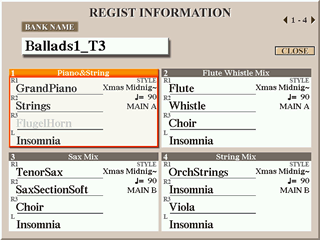 A
registration file (also called a registration bank) holds information for
what is stored in the 8 registration memory buttons. A feature that was new
on the Tyros3 is an INFO button
that will show you what is stored in that registration file. I selected the Ballads1_T3 registration file and pressed the
upper [6] button which opened the REGIST INFORMATION screen. The [TAB] buttons
are used to toggle between the first four registration entries and the last
four entries. The [F] button closes this screen. The first registration
button [RM1] has a GrandPiano as the R1 voice
and Strings as the R2 voice
with Insomnia ad the Left-hand voice. It is using
the MAIN A variation of a style called Xmas Midnight at
a tempo of 90.
A
registration file (also called a registration bank) holds information for
what is stored in the 8 registration memory buttons. A feature that was new
on the Tyros3 is an INFO button
that will show you what is stored in that registration file. I selected the Ballads1_T3 registration file and pressed the
upper [6] button which opened the REGIST INFORMATION screen. The [TAB] buttons
are used to toggle between the first four registration entries and the last
four entries. The [F] button closes this screen. The first registration
button [RM1] has a GrandPiano as the R1 voice
and Strings as the R2 voice
with Insomnia ad the Left-hand voice. It is using
the MAIN A variation of a style called Xmas Midnight at
a tempo of 90.
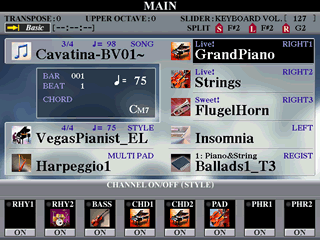 Selecting
this registration and returning to the MAIN screen I can see that the REGIST
cell now shows Ballads1_T3 as the loaded registration file. I
had also pressed the first registration memory button so you see that the
R1, R2, and L voices have all changed and the REGIST cell also shows the
name of this registration memory button, "Piano&String". But
the STYLE hasn't changed. I do not have the style called for in that registration,
so the currently loaded style remains in place, but I do have the new voices
from that registration.
Selecting
this registration and returning to the MAIN screen I can see that the REGIST
cell now shows Ballads1_T3 as the loaded registration file. I
had also pressed the first registration memory button so you see that the
R1, R2, and L voices have all changed and the REGIST cell also shows the
name of this registration memory button, "Piano&String". But
the STYLE hasn't changed. I do not have the style called for in that registration,
so the currently loaded style remains in place, but I do have the new voices
from that registration.
[Murray Best's Registration File Manager program can be used to convert a registration made for one keyboard so that it can be used on a different keyboard.]
Music Finder Files
There is one set of files in our example files group that have not yet been seen in any of the screen shots - the Music Finder data files (.mfd). Unlike all the other types of files used in your Yamaha keyboard, you can not access the Music Finder files from the MAIN screen. Since we have a whole section devoted to the Music Finder, I'll delay the discussion of how to access and use external Music Finder files to that section.
Summary
Each of the various file types used with your Yamaha keyboard has its own display screen where you are shown only files appropriate for what you are trying to do, i.e. if you are trying to load a style file, you will only see style files.
All of the display screens work exactly the same way. The TAB buttons are used to move between the various file storage areas (PRESET, CARD/FLOPPY, USB, HD). The letter buttons are used to select and open subfolders or to select and load files. If a directory has more than 10 files and folders, the numbered buttons are used to select "pages" of your file directory, each of which shows only 10 items.
If a file has a file extension not understood by your keyboard, it will not be shown anywhere. Some files are meant for specific keyboards and will not load in any other keyboard. File names can be very long, but only a limited number of characters (8 to 22) can be shown in the display screen, capital letters take up more space than lower-case letters, wide characters take up more space than narrow characters.
Now that you know how to find and load files, the next lesson will cover what you can do with those files besides simply load them into your keyboard.
This page updated on September 19, 2024 .
